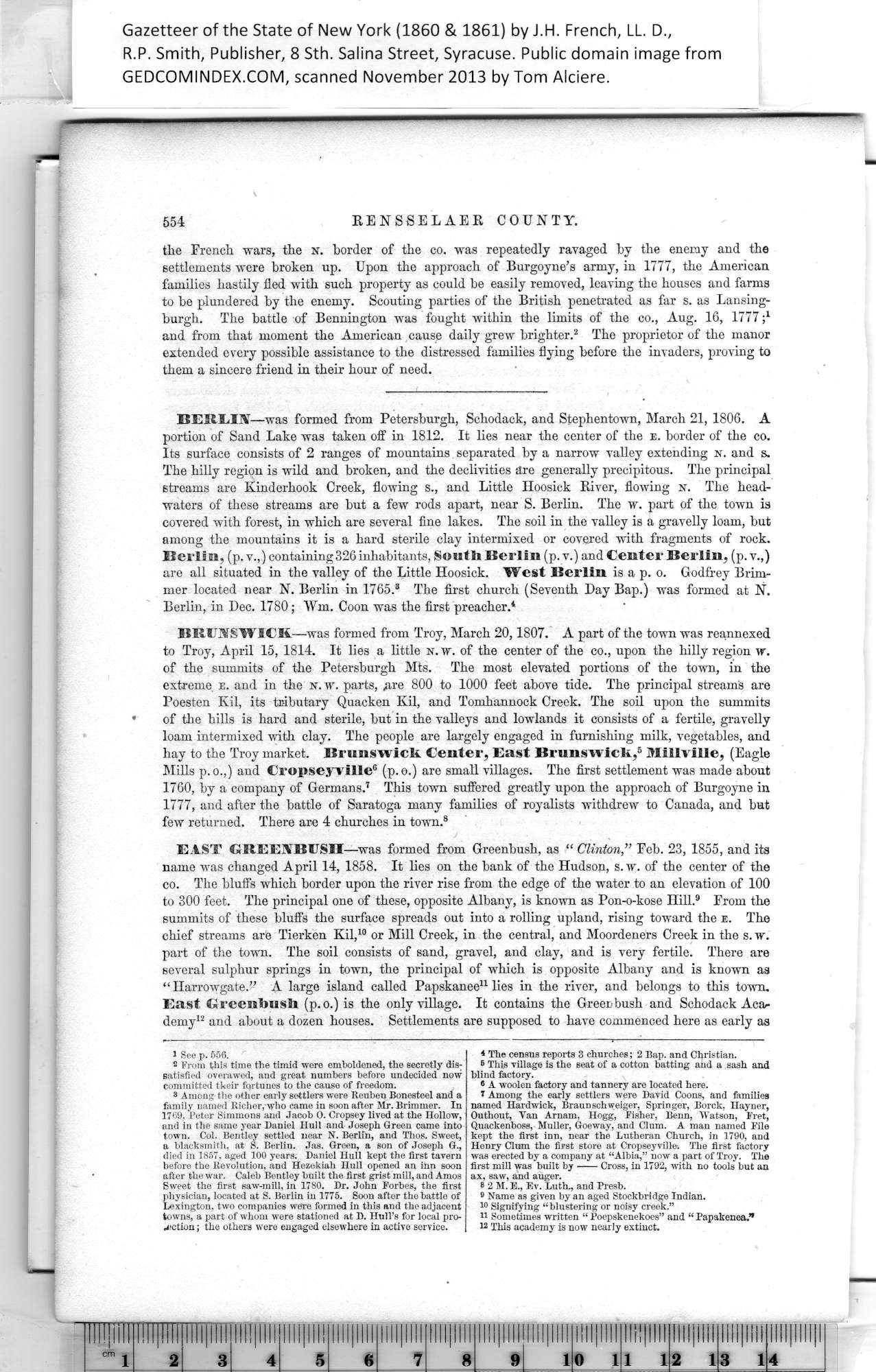|
554 RENSSELAER COUNTY.
the French wars, the sr. border of the co. was repeatedly ravaged by the enemy and the
settlements were broken up. Upon the approach of Burgoyne’s army, in 1777, the American
families hastily fled with such property as could be easily removed, leaving the houses and farms
to be plundered by the enemy. Scouting parties of the British penetrated as far s. as Lansing¬
burgh. The battle of Bennington was fought within the limits of the co., Aug. 16, 1777 ;4
and from that moment the American cause daily grew brighter.2 The proprietor of the manor
extended every possible assistance to the distressed families flying before the invaders, proving to
them a sincere friend in their hour of need.
BERLIN—was formed from Petersburgh, Schodack, and Stephentown, March 21, 1806. A
portion of Sand Lake was taken off in 1812. It lies near the center of the e. border of the co.
Its surface consists of 2 ranges of mountains separated by a narrow valley extending n. and s.
The hilly region is wild and broken, and the declivities are generally precipitous. The principal
streams are Kinderhook Creek, flowing s., and Little Hoosick River, flowing n. The head¬
waters of these streams are but a few rods apart, near S. Berlin. The w. part of the town is
covered with forest, in which are several fine lakes. The soil in the valley is a gravelly loam, but
among the mountains it is a hard sterile clay intermixed or covered with fragments of rock.
Berlin, (p. v.,) containing 326 inhabitants, South Berlin (p. v.) and Center Berlin, (p. v.,)
are all situated in the valley of the Little Hoosick. West Berlin is a p. o. Godfrey Brim¬
mer located near N. Berlin in 1765.1 The first church (Seventh Day Bap.) was formed at N.
Berlin, in Dec. 1780; ¥m. Coon was the first preacher.4
BBIIMSWICK.—was formed from Troy, March 20,1807. A part of the town was reannexed
to Troy, April 15, 1814. It lies a little n. w. of the center of the co., upon the hilly region w.
of the summits of the Petersburgh Mts. The most elevated portions of the town, in the
extreme e. and in the N.w. parts, .are 800 to 1000 feet above tide. The principal streams are
Poesten Kil, its tributary Quacken Kil, and Tomhannock Creek. The soil upon the summits
of the hills is hard and sterile, but in the valleys and lowlands it consists of a fertile, gravelly
loam intermixed with clay. The people are largely engaged in furnishing milk, vegetables, and
hay to the Troy market. Brunswick Center, Bast Brunswick,5 Millville, (Eagle
Mills p.o.,) and Cropseyville6 (p.o.) are small villages. The first settlement was made about
1760, by a company of Germans.7 This town suffered greatly upon the approach of Burgoyne in
1777, and after the battle of Saratoga many families of royalists withdrew to Canada, and but
few returned. There are 4 churches in town.8
EAST GREElfBUSH—■was formed from Greenbush, as “ Clinton,” Feb. 23, 1855, and its
name was changed April 14, 1858. It lies on the bank of the Hudson, s. w. of the center of the
co. The bluffs which border upon the river rise from the edge of the water to an elevation of 100
to 300 feet. The principal one of these, opposite Albany, is known as Pon-o-kose Hill.9 From the
summits of these bluffs the surface spreads out into a rolling upland, rising toward the e. The
chief streams are Tierken Kil,10 or Mill Creek, in the central, and Moordeners Creek in the s. w.
part of the town. The soil consists of sand, gravel, and clay, and is very fertile. There are
several sulphur springs in town, the principal of which is opposite Albany and is known as
“ Harrowgate.A large island called Papskanee11 lies in the river, and belongs to this town.
East Greeubusk (p.o.) is the only village. It contains the Greenbush and Schodack Aca-
demy12 and about a dozen houses. Settlements are supposed to have commenced here as early as
|
* The census reports 3 churches; 2 Bap. and Christian.
8 This village is the seat of a cotton batting and a sash and
blind factory.
6 A woolen factory and tannery are located here.
I Among the early settlers were David Coons, and families
named Hardwick, Braunschweiger, Springer, Borck, Hayner,
Outhout, Van Arnam, Hogg, Fisher, Benn, Watson, Fret,
Quackenboss, Muller, Goeway, and Clum. A man named File
kept the first inn, near the Lutheran Church, in 1790, and
Henry Clum the first store at Cropseyville. The first factory
was erected by a company at “Albia,” now a part of Troy. The
first mill was built by Cross, in 1792, with no tools but an
ax, saw, and auger.
8 2 M. E., Ev. Luth., and Presb.
® Name as given by an aged Stockbridge Indian.
10 Signifying “blustering or noisy creek.”
II Sometimes written “ Poepskenekoes” and “ Papakenea."
12 This academy is now nearly extinct. |
1
Among the other early settlers were Reuben Bonesteel and a
family named Richer, who came in soon after Mr. Brimmer. In
1769, Peter Simmons and Jacob O. Cropsey lived at the Hollow,
and in the same year Daniel Hull and Joseph Green came into
town. Col. Bentley settled near N. Berlin, and Thos. Sweet,
a blacksmith, at S. Berlin. Jas. Green, a son of Joseph G.,
died in 1857, aged 100 years. Daniel Hull kept the first tavern
before the Revolution, and Hezekiah Hull opened an inn soon
after the war. Caleb Bentley built the first grist mill, and Amos
Sweet the first saw-mill, in 1780. Dr. John Forbes, the first
physician, located at S. Berlin in 1775. Soon after the battle of
Lexington, two companies were formed in this and the adjacent
towns, a part of whom were stationed at D. Hull’s for local pro¬
motion ; the others were engaged elsewhere in active service.
|
